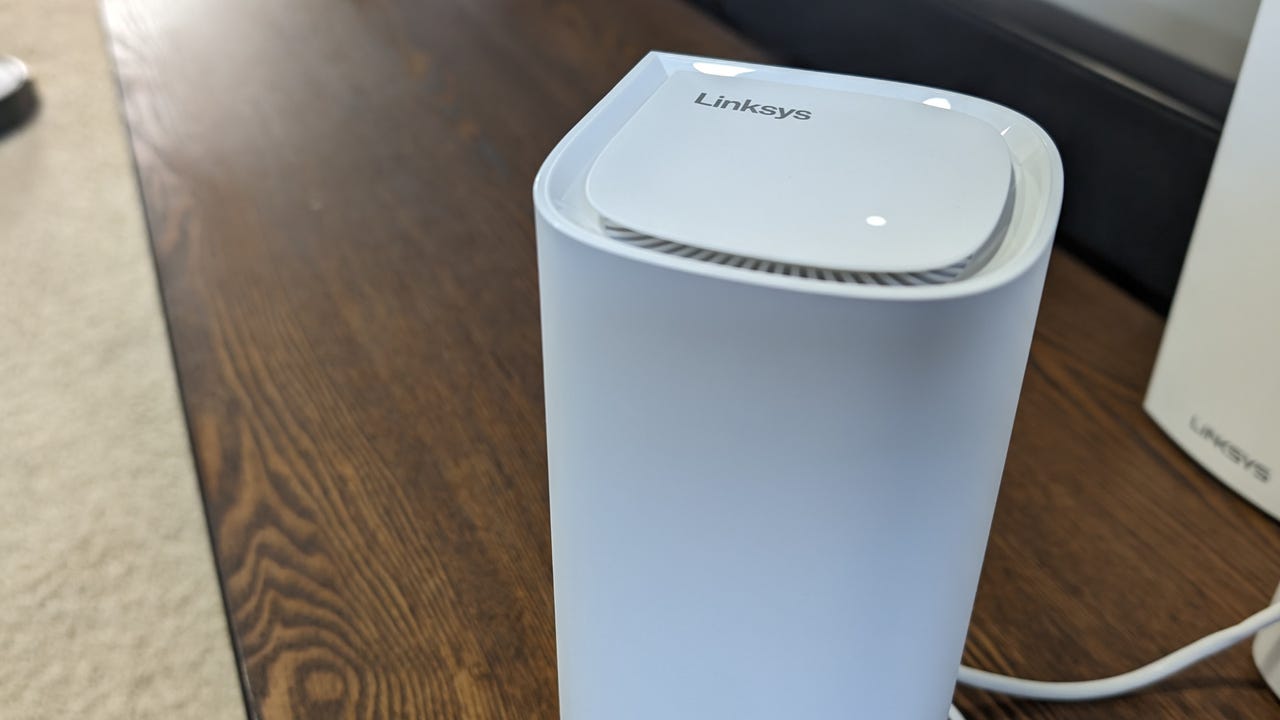
































TheLinksys Velop 7 is a powerful mesh router that isn't an eyesore.
I've been a fan of Linksys mesh routers for some time. I've used the Velop series for years and have found them to be seriously reliable mesh routers. Because I live in a 3,000-square-foot home, a mesh network is a must if I want Wi-Fi connectivity without dead zones. This is especially true, given I work out in my basement and need connectivity for the television that stands in front of my treadmill and rowing machine.
Also: Mesh routers vs. Wi-Fi routers: What is best for your home office?
Recently, Linksys released theVelop 7 Pro tri-band mesh router . Although it's pricey (at$400 per node), it's on par (or cheaper) than other wireless mesh routers that support Wi-Fi 7.
This wireless mesh router can easily cover 1,000 square feet per node, without slowdowns or drops.
What is Wi-Fi 7? Also known as 802.11be or Extremely High Throughput, Wi-Fi 7 can deliver wireless speeds that are considerably faster than other routers. It does this by packing more data into each transmission using 320 MHz channels (which are twice the size of previous wireless generations). Wi-Fi 7 not only features faster connectivity, but better reliability, wired-like responsiveness, and enhanced security.
Also: The best mesh routers you can buy
What is a mesh network? If this is your next question, you're probably not alone. A mesh network uses nodes to create a sort of "net" over a larger area such that it can cover a much wider range. With a mesh network, you set up a main node and then add other nodes to it. Essentially, every node works together to create one very wide wireless network.
Fortunately, most mesh networks handle the provisioning of configurations to each node from the main node, so you don't have to manually configure them. And with the Linksys mesh networks, it's all done from a mobile app, which is very user-friendly. With the Linksys app (for Android and iOS), anyone (of any skill level) shouldn't have a problem setting up the Velop 7 Pro mesh network.
For those who like to review a device's specifications, here they are.
You can connect up to four devices, via CAT 5, to the Velop 7.
A three-pack of the Velop 7 Pro will cover up to 3,000 square feet, so it's pretty safe to assume each node covers 1,000 square feet. With that in mind, you can purchase the number of nodes you need to cover your entire house.
Before setting up the Velop 7 Pro, my mesh network was supplied by a Linksys Velop MX5300 tri-band Wi-Fi 6 router, using only two nodes. With that network, the telling issue was that sometimes -- while watching Hulu on the basement television -- shows would pixelate or not even play.
I added the Velop 7 mesh network and plugged the basement television into the node with a CAT 5 cable. The first test was to turn the television on and see how things looked with Hulu. To my surprise, the pixelation never appeared and every episode or film I started played exactly as expected.
Also: Switching to better internet? Do these 5 things before you change ISPs
My next step was to run a speed test. On my desktop (running Ubuntu Budgie), I pointed my browser to speedtest.net and fired up the test while connected to my original mesh network. Next, I connected to the new wireless network and ran the same test with the same browser. I have three wireless networks to choose from and here are the average results:
Clearly, neither mesh network can compete with the ATT Fiber wireless router (with each connecting directly via CAT 5). However, the ATT Fiber wireless doesn't produce a strong enough signal to be effective in the basement (especially for the television). And given that the Velop 7 is just 150 Mbps (on average) slower than the ATT wireless, that's still quite serviceable (especially compared to the MX5300).
Also: 10 ways to speed up your internet connection today
So, for pure connectivity, the Velop 7 Pro mesh network is a big win, especially considering it covers the entire house without the slightest drop in signal or dead zone. In fact, I ran the same speed test (on a MacBook Pro M1) in every room of the house and the speeds of the Velop 7 didn't fluctuate by enough to make a difference.
This is as solid a mesh network as I've ever used. And with speed enough to stream Hulu (and other services) in the basement (with the main node on the top floor), the Velop 7 seriously impressed me.
You may think$400 is pricey for a wireless router, but when you have a large house and need every square inch covered in Wi-Fi connectivity, the price is worth it. If you can afford enough nodes to cover the expanse of your home, you'll find all the frustrations of trying to force a traditional route to do the job melt away. And with an ease of installation that anyone can handle, this mesh network is a no-brainer to recommend.
 Tags quentes :
Rede
Rede doméstica
Tags quentes :
Rede
Rede doméstica